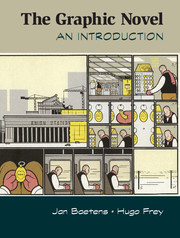Book contents
- Frontmatter
- Contents
- List of illustrations
- Acknowledgments
- 1 Introduction: The Graphic Novel, a Special Type of Comics
- Part One Historical Context
- 2 Adult Comics before the Graphic Novel: From Moral Panic to Pop Art Sensationalism, 1945–c.1967
- 3 Underground Comix and Mainstream Evolutions, 1968–c.1980
- 4 “Not Just for Kids”: Clever Comics and the New Graphic Novels
- Part Two Forms
- Part Three Themes
- Notes
- Index
2 - Adult Comics before the Graphic Novel: From Moral Panic to Pop Art Sensationalism, 1945–c.1967
Published online by Cambridge University Press: 05 October 2014
- Frontmatter
- Contents
- List of illustrations
- Acknowledgments
- 1 Introduction: The Graphic Novel, a Special Type of Comics
- Part One Historical Context
- 2 Adult Comics before the Graphic Novel: From Moral Panic to Pop Art Sensationalism, 1945–c.1967
- 3 Underground Comix and Mainstream Evolutions, 1968–c.1980
- 4 “Not Just for Kids”: Clever Comics and the New Graphic Novels
- Part Two Forms
- Part Three Themes
- Notes
- Index
Summary
This chapter introduces a period in the history of comics when the idea of the graphic novel barely existed. In retrospect, the 1950s and 1960s nevertheless represent a crucial backdrop to the subject of this book. It was in the early part of this period that the comics tradition was accused of pandering to base themes of violence and even encouraging criminality in the young. Familiarity with the anti-comics crusade is instructive because the period has become a significant theme in present-day production, the memory of the period still proving influential on the graphic novel. It is also the case that censorship of horror and crime comics forced publishers to tackle new themes, notably adult satire on culture and societal values, and it is here that one finds antecedents to the graphic novel in work from Harvey Kurtzman. As the 1950s drew to a close, it is a moot point whether Roy Lichtenstein’s, Andy Warhol’s, or Mel Ramos’s appropriation of superhero, war, and romance comics for their Pop Art “saved” comics from the cultural margins. What is significant for us is that while comics received a new burst of creative energy, significant parts of that process influenced future graphic novel production, opening up classic comics to freewheeling reinterpretations, narrative dualism, and appropriation.
Censorship and renewed creativity
A picture can be worth a thousand words, and this is surely the case of press photography dating from the late 1940s that shows groups of cheering young American people, boys and girls, gathered around huge trash bins that contain burning papers. These types of image are powerful because they play with our existing historical assumptions. On the one hand, the image of burning pyres of paper materials and a moblike crowd taps into our collective memories of similar historic scenes from Nazi Germany, where the totalitarian state organized the destruction of books deemed dangerous to readers. On the other hand, the youths pictured are clearly dressed in North American garb, and there is not a single Swastika or military uniform in the pictures. In fact, this scene is from 1949, Bennington, New York, and it portrays to how pupils at the St. Patrick’s Academy set about burning their comic books in a public display of contempt and self-purification.
- Type
- Chapter
- Information
- The Graphic NovelAn Introduction, pp. 27 - 53Publisher: Cambridge University PressPrint publication year: 2014



